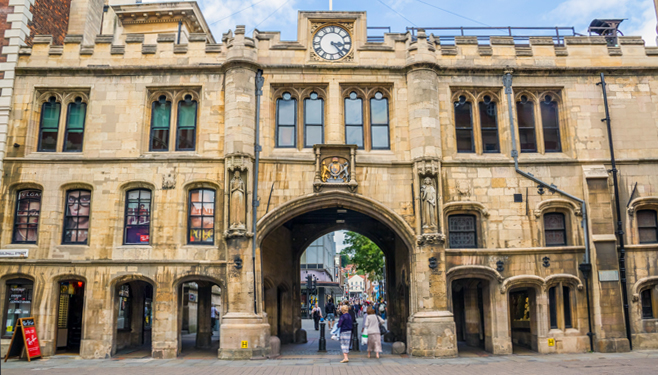Introduction
Lincoln Guildhall, located above the Stonebow in the heart of Lincoln, England, is a historic building that serves as a symbol of the city’s civic heritage. This iconic structure, with its blend of medieval and Tudor architecture, has been a center of governance and administration in Lincoln for centuries. It is not only a prominent architectural landmark but also a repository of the city’s rich history, filled with artifacts and stories that reflect Lincoln’s evolution through the ages. This essay explores the history, architectural features, and cultural significance of Lincoln Guildhall, highlighting its role in the civic life of Lincoln.
Historical Background
The origins of Lincoln Guildhall can be traced back to the medieval period when Lincoln was an important center of trade and governance in England. The Guildhall was established as the administrative headquarters for the city’s Corporation, the body responsible for local governance, justice, and trade regulation. The building, which is situated above the Stonebow, a medieval gateway that forms part of Lincoln’s southern city walls, has been in continuous use for civic purposes since its construction.
The Stonebow itself dates back to the late 14th century and was built on the site of a Roman gateway. The Guildhall above was added in the early 16th century, reflecting the city’s need for a dedicated space for its growing civic functions. The combination of the Stonebow and Guildhall creates a unique architectural ensemble that symbolizes the continuity of civic governance in Lincoln from Roman times through to the present day.
Throughout its history, Lincoln Guildhall has been the venue for a variety of civic activities, including meetings of the City Council, mayoral ceremonies, and judicial proceedings. The building has witnessed significant historical events, such as royal visits and proclamations, and has served as a focal point for the city’s public life. Its continued use as a civic building makes it one of the oldest functioning guildhalls in England, and it remains an important symbol of Lincoln’s civic identity.
Architectural Features
Lincoln Guildhall is an architectural marvel that combines elements of medieval and Tudor design. Its location above the Stonebow, a medieval gateway that once marked the southern entrance to the city, adds to its historical significance and visual impact.
1. The Stonebow
The Stonebow is a medieval gatehouse that forms the base of Lincoln Guildhall. It was constructed in the late 14th century, likely replacing an earlier Roman gateway that once stood on the site. The Stonebow was designed as both a defensive structure and a ceremonial gateway, reflecting its dual role in protecting the city and serving as a symbol of civic pride.
The Stonebow is characterized by its impressive archway, which allows traffic to pass beneath the Guildhall. The arch is flanked by two towers, each adorned with crenellations and small windows that suggest its original defensive purpose. Above the archway, the Guildhall rises, creating a striking visual contrast between the solid stone of the medieval gatehouse and the timber-framed construction of the building above.
2. The Guildhall
The Guildhall above the Stonebow was constructed in the early 16th century, during the Tudor period. Its architecture reflects the civic aspirations of Lincoln at the time, combining elements of both medieval and Tudor design. The exterior of the Guildhall is notable for its timber-framed construction, with large windows that provide a sense of openness and lightness in contrast to the more solid and defensive appearance of the Stonebow below.
The interior of the Guildhall features a number of historic rooms, including the Council Chamber, the Mayor’s Parlour, and the Courtroom. These spaces are richly decorated with wood paneling, stained glass, and ornate plasterwork, reflecting the importance of the building as a center of civic life. The Council Chamber, in particular, is a highlight of the Guildhall, with its large windows overlooking the High Street and its historic furnishings, including the original council table and chairs.
3. Historic Artifacts and Furnishings
Lincoln Guildhall houses a remarkable collection of historic artifacts and furnishings that reflect its long history as a center of governance and administration. Among the most notable items are the civic regalia, which include the Mayor’s chain of office, ceremonial swords, and maces. These items are symbols of the authority and continuity of Lincoln’s civic leadership, and they are displayed in the Guildhall’s main rooms during official ceremonies.
The Guildhall also contains a collection of historic paintings, including portraits of past mayors and civic leaders. These paintings provide a visual record of the individuals who have shaped Lincoln’s history over the centuries and serve as a reminder of the city’s rich civic heritage. Other notable items include the city’s charter, which dates back to the 13th century, and various legal documents and records that reflect the Guildhall’s role in the administration of justice.
Cultural and Civic Significance
Lincoln Guildhall is not only an architectural and historical landmark but also a vibrant symbol of the city’s civic heritage. It continues to play a central role in the life of Lincoln, hosting a variety of civic events, ceremonies, and public functions.
1. Civic Ceremonies and Functions
One of the primary functions of Lincoln Guildhall is to serve as the venue for civic ceremonies and functions. The Guildhall is the official residence of the Mayor of Lincoln, and it is used for a variety of ceremonial events, including mayoral installations, civic receptions, and the presentation of awards and honors.
The Guildhall’s historic Council Chamber is where the City Council meets to discuss and decide on matters of local governance. These meetings are open to the public, reflecting the Guildhall’s role as a place of civic engagement and transparency. The building’s continued use for these purposes underscores its importance as a living symbol of Lincoln’s democratic traditions.
2. Public Access and Tours
Lincoln Guildhall is open to the public, offering visitors the opportunity to explore its historic rooms and learn about the city’s civic history. Guided tours are available, providing insights into the building’s architecture, the significance of its artifacts, and the role it has played in the governance of Lincoln over the centuries.
These tours often include access to the Council Chamber, the Mayor’s Parlour, and other key rooms, as well as a chance to view the civic regalia and other historic items. By opening its doors to the public, the Guildhall serves as an educational resource and a means of connecting the people of Lincoln with their city’s heritage.
3. A Symbol of Continuity and Tradition
Lincoln Guildhall stands as a powerful symbol of continuity and tradition in a rapidly changing world. Its long history as a center of civic governance and its ongoing use for this purpose make it a unique and enduring feature of Lincoln’s urban landscape. The building embodies the city’s civic pride and its commitment to preserving its heritage while adapting to the needs of modern governance.
The Guildhall’s location above the Stonebow, at the heart of Lincoln’s bustling High Street, also symbolizes the close connection between the city’s past and present. It serves as a reminder that the traditions of civic duty and public service have deep roots in Lincoln’s history and continue to play a vital role in the city’s identity.
Preservation and Challenges
Preserving the historic character of Lincoln Guildhall while ensuring its functionality as a modern civic building presents a number of challenges. As a Grade I listed building, the Guildhall is protected by law, which imposes strict regulations on any alterations or repairs to its structure. This status helps to ensure that the building’s historical features are preserved for future generations.
However, maintaining such an old building also requires careful management of issues related to aging materials, structural integrity, and the need for modern amenities. Efforts to preserve the Guildhall include regular inspections, conservation of historic artifacts, and sensitive upgrades to the building’s infrastructure, such as heating, lighting, and accessibility improvements.
Conclusion
Lincoln Guildhall is a historic and architectural treasure that embodies the civic heritage of Lincoln. From its origins as a medieval gateway and administrative center to its current role as the heart of the city’s civic life, the Guildhall has been a constant presence in Lincoln’s history. Its distinctive architecture, rich collection of artifacts, and ongoing use for civic functions make it a unique and valuable part of Lincoln’s heritage.
As a symbol of continuity, tradition, and civic pride, Lincoln Guildhall continues to play an essential role in the life of the city. It serves not only as a link to Lincoln’s past but also as a living institution that engages with the community and contributes to the city’s identity. Through its preservation and public engagement, Lincoln Guildhall remains a vibrant and enduring testament to the civic spirit of Lincoln.



